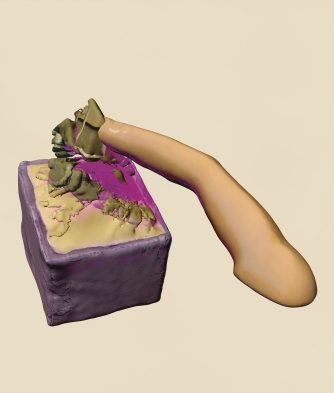Shahryar Nashat
*1975 Genf, lebt und arbeitet in Los Angeles
https://www.shahryarnashat.com/September 2021
-
 Untitled, 2021 UV-Digitaldruck auf Aluminium
Untitled, 2021 UV-Digitaldruck auf Aluminium
Auflage: 0
Abmessung: 50,80 x 43,30 x 2,00 cm
Produktion: Shahryar Nashat Studio, Los Angeles
CHF 2’800.00
Das neue Objekt von Shahryar Nashat basiert auf dem 3D-Scan eines Ellenbogens, der mit unsichtbarer Hand eine Wirkung auf eine Skulptur ausübt. Die quaderförmige Skulptur, die in dieser Arbeit zu sehen ist, wurde in der Ausstellung des Künstlers mit dem Titel «They Come To Touch» in 8762 Holloway Drive in Los Angeles präsentiert, einem modernistischen Geschäftshaus, das von Rudolph Schindler gebaut wurde. «They Come To Touch» funktioniert perfekt als Beschreibung der neuen Arbeit. Die mechanische Abtastung der Kamera fängt die Skulptur und eine Partie dieses speziellen Körperteils in einem nicht näher beschriebenen digitalen Raum ein, in dem eine technische Störung im Raum zwischen Subjekt und Objekt eintritt. Das Scan-Gerät kann zwischen Körperteil und Objekt nicht unterschieden. Die Fotodarstellung ist also nicht real, sondern ein technologisches Versagen bei der Übersetzung der Formen. Wie bei den meisten von Nashats Arbeiten könnte der Raum überall sein, der Ellenbogen könnte von jedem sein. Die Werkserie besteht aus 17 Unikaten, da jeder Druck einen anderen Fluchtpunkt und eine andere Perspektive abbildet. Die Farben ähneln viszeralen, unnatürlichen Tönen und stehen im Einklang mit der üblichen Farbwahl des Künstlers wie Rotbraun, Gelb und Lila. Die Arbeit wurde mit Acryl grundiert und versiegelt, bevor der industrielle UV-Druck, fast wie ein haptisches Relief, appliziert wurde. Sie kann als Wandskulptur betrachtet werden, nicht nur, weil Nashat hauptsächlich mit Installationen arbeitet, sondern schon deshalb, weil das massive Stück Aluminium 2 cm dick ist und etwa 10 kg wiegt.
Die Fotografie basiert auf computergenerierten Bildern. Es ist eine Konversion der Körperlichkeit und der Unkörperlichkeit der beiden Objekte in visuelle, mentale und physische Darstellungen. In diesem spielerischen Ansatz versucht Nashat, Technologie, Objekthaftigkeit und unsere körperlichen Fähigkeiten in neuen digitalen Formaten der Fotografie dialektisch zu verfremden, aber auch zu versöhnen. Das Werk setzt seine Erkundung von Körpern und seine Untersuchung der Erfahrung von digitalen und visuellen, aber auch physischen und gedanklichen Räumen fort. Es ist eine Transformation von Innen und Aussen, Technologie und Körper, Natur und Kultur. Die Arbeit kann als Allegorie des menschlichen Wunsches gelesen werden, Kunstobjekte und Körper im Raum in Bezug auf ihre Darstellung zu begreifen. Wie in seinen letzten Ausstellungen erprobt der Künstler, wie Körper und Kunstwerke gesehen, gefühlt und wahrgenommen werden können. Dabei dienen ihm oft technologische Innovationen als Prothesen, die die Fähigkeiten und Funktionen der menschlichen Gestalt erweitern. Körperteile, Objekte und Lebenserfahrungen zeigen die heutige Fragmentierung des Bewusstseins und des Körpers durch Technologie und Mediatisierung. Die dargestellte Körperlichkeit scheint uns beständige Sehnsucht nach Intimität mitzuteilen. Wir sehen sie gleichsam als organische und zerbrechliche Objekte, die nicht vollständig erfasst werden können. DK